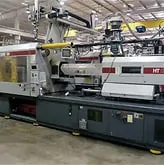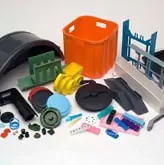(click on thumbnail to enlarge)


At Lerner Molded Plastics, we provide custom plastic injection molding to customers in a variety of industries all over the United States. Equipped with more than three decades of plastic manufacturing experience and a state-of-the-art injection molding facility, we have what it takes to provide high-quality custom molded plastic components at competitive prices.
Plastic injection molding is a manufacturing process that involves melting plastic material and injecting it at high pressures into a pre-shaped mold to create the desired parts and products. It is highly versatile, allowing manufacturers to turn thermoplastic and thermoset materials into a wide range of components in various shapes and sizes.
Plastic Injection Molding Capabilities at Lerner Molded Plastics
The plastic manufacturing experts at Lerner specialize in multi-cavity injection molding for intricate components. This production method allows for the creation of multiple parts per production cycle, which translates to better production efficiency and faster production times without sacrificing product quality.
In addition to our multi-cavity injection molding capabilities, we also offer standard injection molding services for various plastic materials. Our injection molding presses achieve clamping forces between 30 to 3,000 tons for up to 64 mold cavities and accommodate thermoplastics and thermosets (ABS, acetal, acrylic, HDPE, polycarbonate, polyester, polypropylene, and polystyrene) in a variety of standard and custom colors. Additionally, they allow for shot sizes from 3 to 600 oz, which enables us to produce very small to very large parts.
Overview of the Plastic Injection Molding Process
While the plastic injection molding process may vary slightly from company to company, most operations follow the same basic steps:
- Mold Creation: The mold is one of the key components for injection molding operations. If designed and constructed properly, it produces molded components that meet the necessary specifications.
- Clamping: Injection molding molds consist of two halves, each of which must be securely fastened to the injection molding machine before the operation. The machine’s clamping unit ensures the two halves are closed with the appropriate amount of force to prevent mold separation and material leakage before, during, and after the injection stage.
- Injection: A hopper feeds the plastic material into a heated barrel and screw mechanism. The barrel melts the plastic, while the rotating screw pushes the melted plastic toward the injection head. The injection head deposits a measured amount of melted plastic into the mold at high pressure, ensuring every part of the mold is filled.
- Cooling: Once the molten plastic has been injected, it is allowed to cool and harden until it maintains the shape of the mold.
- Ejection: Once the molded part is adequately cooled, it is ejected from the mold.
- Finishing: Injection molded components typically require some post-processing. For example, if flash is present, the excess material must be removed through cutting, grinding, tumbling, or other similar removal methods.
Advantages of Plastic Injection Molding
Compared to other manufacturing methods, the plastic injection molding process offers many advantages, such as:
- Better efficiency: Once the molds are created, the actual injection molding operation proceeds much faster than the molding operations of other molding methods. By using multi-cavity molds, manufacturers can produce multiple components during a single cycle, resulting in even higher production output.
- Greater accuracy: The injection molding process can achieve tolerances of ±.001 inches, making it highly suitable for complex and intricate designs.
- Smaller waste generation: Injection molding allows manufacturers to measure out the exact amount of material needed for a given component, thereby reducing material waste. Additionally, thermoplastic scraps can be recycled for use in future injection molding operations.
- Lower labor costs: The injection molding process is highly automated, which allows for the creation of multiple components on a machine controlled by a single operator or technician. This significantly reduces the number of people necessary for a project.
- Broader material and color options: The plastic injection molding process accommodates a variety of polymers in an array of colors, which makes it easier for manufacturers to choose a material that meets their functional and aesthetic requirements.
Who Uses Plastic Injection Molding?
Manufacturers employ the plastic injection molding process to produce a wide range of parts and products. Some of the industries that utilize injection molded components include:
- The Food and Beverage industry for equipment components, food/beverage containers, container caps/lids, and utensils
- The Medical and Pharmaceutical industry for surgical, diagnostic, and test equipment components and miscellaneous part/product components
- The Construction industry for doors, windows, and other non-structural components
At Lerner Molded Plastics, we regularly provide injection molding services to customers in the following industries:
- Automotive
- Consumer Goods
- Housewares
- OEM
- Toys
Lerner Molded Plastics: Your Plastic Injection Molding Expert and Partner
Throughout our over 35 years in business, we’ve developed a reputation as a top plastic injection molding company. If you need a partner for your next injection molding project, the plastic manufacturing experts at Lerner are here to help. To learn more about our injection molding capabilities or discuss your project specifications, contact us or request a quote today.
Precision Injection Molding Capabilities
| General Custom Injection Molding Capabilities | Custom Offshore |
||
| Product Capabilities |
|
||
| Mold Process Type | Injection | ||
| Material |
|
||
| Colors | Custom | ||
| Clamping Force |
|
||
| Shot Size |
|
||
| Number of Cavities |
|
||
| Secondary Services | In-Line or Post Molded Secondary Assembly Ultrasonic Welding Part Decorating (Hot Stamping, Pad Printing, Painting) Bar Coding and Labeling Complete Packout Services Warehousing Services and Drop Ship Capability All Material, Packaging, and Components Sourcing Complete Supply Chain Services Product Distribution Logistics Engineering Product Development Mold Making Tooling Vendor Managed Inventory Programs Kanban |
||
| Production Volume | Prototype Runs to Full Production Capacity |
Additional Information
| Industry Focus |
|
||
| Intended Application |
|
||
| Industry Standards | ISO Certified | ||
| File Formats | SolidWorks Pro-Engineer |

